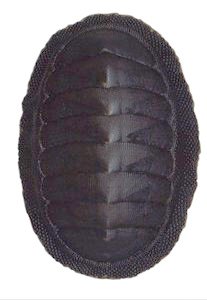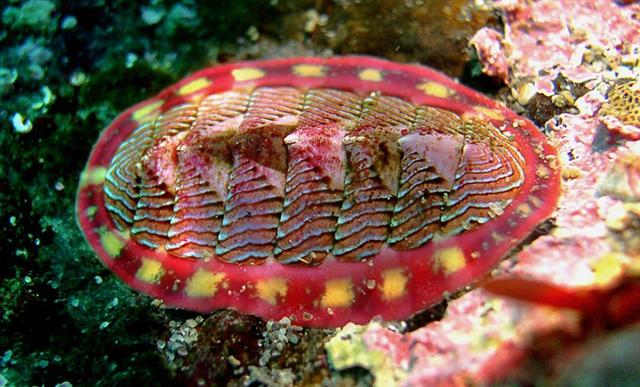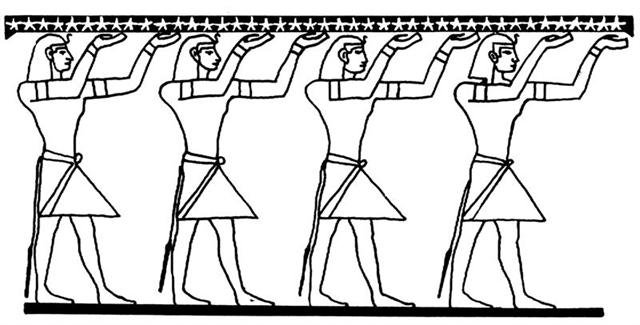In my early perceived calendar for the year I had decided the pair of mama glyphs had to be at midsummer:
... Raven began to search for the girls. For it is the way of things in the world that there are both males and females of every creature. Somewhere there must be girls. Raven searched and searched. Under logs and behind rocks, he looked. But he could not find the hiding place of the first girls. But as he searched, the tide was going out, and as it reached its lowest, the Raven spotted some giant Chitons clinging to the rocks. These giant shell fish had but one shell, fastened tightly to the rocks with huge soft lips around their edges. Raven pried one loose with his beak. And there inside was a girl. He pried off another, and another, and another in each was a girl. They were very similar to the creatures he had found in the clamshell, but more like the Chiton, softer and rounder, in contrast to the hard shell and strong muscles of the clam. And these were just as frightened of the Raven. He gathered them onto his back with difficulty, and brought them to the boys he had found in the clamshell ... What is the difference beetween drawing up land, sucking out the sea, and the tide going out? How many Chitons were there?
My early interpretation is here seen to support the method to count days from the Gate of the Goat. With Haedus II at the beginning of the northern winter solstice (day 355) the solstice would have been in the past around 11 days later, in day 366 = day 1. From January 1 up to and including June 21 there are 172 days and 11 + 172 = 183, equal to the number of days from December 21 (355) to June 22 (538 = 365 + 173). They could have used the distance between the Gate of the Goat and the Hyades Gate as a measure for the length of the winter solstice. Which could explain the absence of eyes at Haedus II - at a solstice the Sun was as if dead, he did not move. Then came winter until spring equinox:.
Counting from the northern spring equinox to the northern summer solstice there are 172 - 80 = 92 days. Glyph 11 + 92 = 103 is Ga4-20:
In a leap-year Ga4-20 would also have this position in time, because then even Ga2-29 would be counted: ... Tegmine is ζ Cancri and the name seems to mean 'covering' - which would be appropriate if it was used only at leap-days. Al Tarf is β Cancri and its name indicates 'end'. Probably the creator of the glyph text meant this manu kake to be at a cardinal point and the 'bird' (the Sun) ought to climb beyond day 59 (or 60 in a leap year) ... There are 4 very special figures from day 4 * 91 + 1 (according to the calendar of the Goat), and in rongorongo times they were coinciding with the days 360 - 364 after 0h. *360 = March 16 (75) and 75 - 75 = ●DECEMBER 31 (365). ... Nut, whom the Greeks sometimes identified with Rhea, was goddess of the sky, but it was debatable if in historical times she was the object of a genuine cult. She was Geb's twin sister and, it was said, married him secretly and against the will of Ra. Angered, Ra had the couple brutally separated by Shu and afterwards decreed that Nut could not bear a child in any given month of any year. Thoth, Plutarch tells us, happily had pity on her. Playing draughts with the Moon, he won in the course of several games a seventy-second part of the Moon's light with which he composed five new days. As these five intercalated days did not belong to the official Egyptian calendar of three hundred and sixty days, Nut was thus able to give birth successively to five children: Osiris, Haroeris (Horus), Set, Isis and Nepthys ... Already from the beginning of my work I have been convinced these 4 were 'Bacabs' and here their position finally can be confirmed as corresponding to raising the sky roof - at the 0h in rongorongo times and after the northern winter solstice at the time of the Goat.
... 'Among the multitude of gods worshipped by these people were four whom they called by the name Bacab. These were, they say, four brothers placed by God when he created the world at its four corners to sustain the heavens lest they fall.' ... 'In the ms. Ritual of the Bacabs, the cantul kuob [the suffix '-ob' indicates plural], cantul bacabob, the four gods, the four bacabs, occur constantly in the incantations, with the four colors, four directions, and their various names and offices.' ... 'This connects up the present section with the beginning of the 'sacred tonalamatl', at the Spring equinox with the Mayas as with the Mexicans, and in the center of the 364-day year (52 days of which preceded and 52 followed the tonalamatl or tzolkin), ruled by its 91-day quarters by the Four Bacabs, whose quarternary repetition (in the 1820-day period) we have thus verified ...'
|
||||||||||||||||||||||||||||||||||||||||||||||||||||||||||||||||||||||||||||||||||||||||||||||||||||||||||||||||||||||||||||||||||||||||||||||||||||||||||||||||||||||||||||||||||||||||||||||||||||||||||||||||||||||||||||||||||||||||||||||||||||||||||























